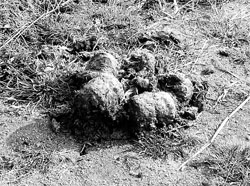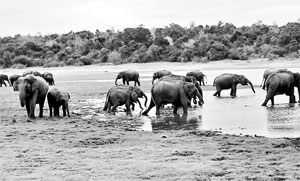The proposed elephant census to be conducted in a few months’ time by the Department of Wildlife Conservation (DWLC) has generated much interest.
An elephant census is no simple activity. Although the elephant is a large animal, sightings can be quite difficult because of forest cover. Also by nature elephants are wary of humans and will retreat into denser habitat when approached. So, counting elephants and making a census, is a much more complex procedure.
What is a census?
Understanding animal abundance, distribution and movement patterns is an important aspect of wildlife management. Measuring abundance of animal populations essentially means census. Most census methods require complex statistical treatment of the data. No doubt some simple techniques, with a minimum of statistical treatment, can yield useful results if undertaken with a clear understanding of assumptions and limitations.
However, this proposed census by the DWLC is, according to reports, a comprehensive island–wide census, with a view of ascertaining the total population of wild elephants in Sri Lanka and their dispersion. Hence this will certainly be a ‘full blown’ census which will be far more complex than a simple area based count to study abundance and movement trends.
Purpose of a census
A census yields numerical information, like population estimates per area, information about relative abundance, or trends. The adjectives “absent, rare, occasional, common, abundant” denote measures of relative abundance, but even this basic information is lacking for the Sri Lankan elephant. We do not even know the population numbers or dynamics in the national wild life parks.
Most often it is efforts by private individuals that yield useful data and information like Dr. Shermin de Silva and Ashoka Ranjeeva’s ongoing in-depth study of the Uda Walawe elephants, over several years now which is throwing out some very interesting information. Whereas originally it was thought that the population in the park was around 300-400, it now appears that the population is as high as 800-1100 during certain periods.
So it is no surprise that there is considerable controversy about the exact number of elephants in the wild in Sri Lanka. Therefore, carrying out a full island-wide comprehensive census is a very important project, and vital to assess the wild elephant population for the purpose of future planning activities.
Techniques
There are several well established techniques that are utilized in undertaking a census. Basically there are two types of techniques - Direct and Indirect methods.
Direct Sighting Method
This involves visibly searching for, and counting the animals in a relatively high density habitat. This method is utilized for larger animals such as the elephants, provided the habitat is conducive for direct sighting. A large number of volunteers is utilized to systematically cover areas and undertake the count.
Total counts
In a total counting, the entire area under surveillance is searched, and all elephants sighted are counted. A disadvantage of this method is that it cannot account for errors (such as double counting), especially when the census is spread over several days. This method would not be preferred for large areas where there are different terrains and habitats. Much more resources will be called for, which often makes the entire exercise prohibitively expensive. Hence this method, on its own, will not be practically applicable for an island wide census of elephants in Sri Lanka.
Sampling
The alternative is to count in a part of the area only, by conducting a number of sample counts. The cumulative sample counts can then be extrapolated to cover the entire area to estimate the total population. However, such sample counts have to be skilfully and scientifically planned and conducted, supported by good statistical analysis, if it is going to provide good and accurate data. The crucial assumption in sampling is that the individual sampling areas should be representative of the entire area being sampled.
Block counting
As opposed to sampling counts, in a block count, observers, move through a selected area or block in a pre-determined pattern assuming that all elephants within this block can be seen, and thus double counting avoided.
The entire area under investigation is first divided up into the counting blocks. The total number of elephants in this area can then be ascertained by either counting all blocks or adding the figures together (i.e. total count) or the more preferred method of estimating from the figures obtained, by counting proportions of blocks only (sample).
Transects
Similar to the block concept, in this case transects or specific routes are used, around which the elephants are counted when sighted. The transects can be fixed width, (useful in open grasslands or scrub jungle where there is adequate lateral visibility) where sightings within a particular distance from the transect only are counted. On the other hand, open width transects involves counting of all sighted elephants, regardless of sighting distance. Obviously each of these techniques will need to supported with relevant mathematical models.
Indirect methods
In cases where density is low, or habitat visibility is poor, an indirect method of assessing numbers must be resorted to. This means that as opposed to direct sightings, some other parameter or signs are used to assess the number of animals in a given area. In the case of elephants the most popular and effective indirect method of assessment is dung counts.
Elephants eat a large quantity of vegetation (some 200 kg a day) and have a relatively poor digestion system ( only some 40% is processed in the stomach). Consequently elephants defecate some 6-8 times a day, leaving behind a trail of large boluses of dung. To scientists’ these dung piles are a storehouse of information. Apart from the more obvious DNA information and health of the animal, it can also give an indication of the elephant movement patterns and abundance.
Therefore in theory it is possible to estimate population size from dung counts, if we know defecation rates and rate of decomposition of the dung. Sample blocks are planned out, and all dung found within that block is counted, and composition and status (how big, how old etc.) noted, from which, using mathematical techniques and proper assumptions, population estimates are arrived at. In practice this is not easy to establish reliably, and this method is not recommended for total population estimation. It is more preferred for analysis of trends.
General requirements
of a census
Timing
The optimum time to carry out the census should be decided when the elephants will be accessible better. Normally, the height of the dry season is best, because during this period elephants would access water holes. On the other hand if it is a wildlife park, high tourist seasons would be best excluded when conducting the census.
Given the current distribution pattern of Sri Lankan elephants in the wild, perhaps a combination of direct and indirect counting should be carried out. In some of the wildlife parks where visibility is good, elephants are relatively more accustomed to people, where perhaps direct counting procedures may be suitable.
However, there will be vast areas where indirect methods will have to be used. Also August, when the census is to be conducted, is the dry season in the North-Eastern region, where there is greater elephant abundance, which perhaps is good timing.
Staffing
Whatever techniques or methods are used, a census of the entire island would require sufficient trained and dependable staff. A properly planned organizational structure will have to be put in place, with separate teams to work under team leaders. Needless to say the entire team must be well accounted with techniques going to be used.
Logistics
During the period of census, there will have to be a major logistics programme in place, to provide the very large number of resource personnel out in the field with adequate food, water, transport and other resources. Effective communication systems have to be set up, with regional and central command centres, to coordinate activities and for collecting of data. After the actual census, considerable collation and analysis of the data will have to be carried out, before a final conclusion can be arrived at.
Past data and information about elephant ranging and abundance should be taken into account when planning out the sample areas to be counted. Given the scarcity of such information (except once again the work done by individual researchers such as Dr Prithiviraj Fernando and Dr Devaka Weerakoon) this will be a daunting task
In the case of Sri Lanka, definitely some areas will have to be counted under sampling techniques and careful planning and expert input will have to be obtained. In addition analysis of the information, post count, is also very vital. Proper standard deviations, error factors and confidence limits, plus sampling size will have to be carefully calculated and decided on.
It is important therefore that the DWLC engage as many experts into the planning process. There is a wealth of knowledge in the hands of private individuals, who are really the only ones carrying out whatever elephant research that is going on in Sri Lanka.
No amount of theoretical knowledge will of course ever substitute for real-life, field experience in planning and executing such a complex and large scale project. And it is a well-known fact that only a very few elephant censuses have been conducted in Sri Lanka, and many of the results arrived at, have been, in fact, questionable. So there is no question that local field experience is quite limited in this area. Therefore we should obtain suitable expertise from abroad, the best being from India, where conditions would be very similar to Sri Lanka.
If all these precautions are taken, with proper and extensive planning, backed by good scientific support, both public and private, then the proposed elephant census would be one of the most important interventions undertaken by the DWLC in the recent past, that would help planning of future wild life management strategies.
More importantly it can set the stage for a healthy private-public sector partnership, which will be of great significance and importance towards addressing the complex human elephant conflict.
(The writer, a keen environmentalist is a senior tourism professional, now attached to the Ceylon Chamber of Commerce as Project Director of the Greening Hotels SWITCH ASIA project.)
|



